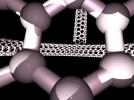
Kick-off meeting of the EU project IST-021285-2 "Carbon nanotube devices at the quantum limit (CARDEQ)" in Regensburg.An international consortium of 7 universities and research centers is seeking to take advantage of the extraordinary electronic properties of carbon nanotubes. The University of Regensburg is participating in this project through the research groups led by Prof. Christoph Strunk and Dr. Gianaurelio Cuniberti of the Physics Department.
Carbon nanotubes have several unique electrical and mechanical properties. They form one class of molecular conductors that provide the ultimate limit for microelectronic miniaturization. Carbon nanotubes are metallic or semiconducting depending on their chirality. Owing to their large length/diameter ratio, the metallic tubes are truly one-dimensional conductors. They have been found technologically manageable as well as robust so that large currents can be passed through them without any damage. The mean free path of electrons can be several microns so that the tubes act as ballistic conductors and, accordingly, transport is virtually noiseless. In addition, superconductivity has been observed in carbon nanotubes, which is extraordinary among 1D-conductors. We propose to extend the operation of HEMT/FET-type of nanotube devices to the quantum limit, and to demonstrate their usefulness in conjunction with a mechanical nanotube resonator serving as a force sensor at sub-attoNewton resolution. These devices include a) Carbon nanotube FET, b) Carbon nanotube rf-SET, and c) Superconducting nanotube transistor. Our devices will provide either unsurpassed sensitivity or band width for the detection of charge and mechanical motion. The development of these three detector-amplifiers, together with optimization of contact resistance and the nanomechanical force sensor, form the basic work packages of this proposal. The final goal is to build a sub-attoNewton force sensor that would act simultaneously as the sensing element and, as well, as its own first stage preamplifier. Our effort belongs foremost to the category of long-term research of foundational nature. Some parts of our work can also be classified as high-risk effort, since the outcome will depend strongly on how rapid progress can be made in understanding the contact resistance between a metal and a nanotube. This is especially true for devices taking advantage of the proximity induced superconductivity in nanotubes. We also want to point out that our devices at the quantum limit have relevance and potential for quantum information processing, which is an aspect of growing importance at present.

Kick-off meeting of the EU project IST-021285-2 "Carbon nanotube devices at the quantum limit (CARDEQ)" in Regensburg.An international consortium of 7 universities and research centers is seeking to take advantage of the extraordinary electronic properties of carbon nanotubes. The University of Regensburg is participating in this project through the research groups led by Prof. Christoph Strunk and Dr. Gianaurelio Cuniberti of the Physics Department.
Carbon nanotubes have several unique electrical and mechanical properties. They form one class of molecular conductors that provide the ultimate limit for microelectronic miniaturization. Carbon nanotubes are metallic or semiconducting depending on their chirality. Owing to their large length/diameter ratio, the metallic tubes are truly one-dimensional conductors. They have been found technologically manageable as well as robust so that large currents can be passed through them without any damage. The mean free path of electrons can be several microns so that the tubes act as ballistic conductors and, accordingly, transport is virtually noiseless. In addition, superconductivity has been observed in carbon nanotubes, which is extraordinary among 1D-conductors. We propose to extend the operation of HEMT/FET-type of nanotube devices to the quantum limit, and to demonstrate their usefulness in conjunction with a mechanical nanotube resonator serving as a force sensor at sub-attoNewton resolution. These devices include a) Carbon nanotube FET, b) Carbon nanotube rf-SET, and c) Superconducting nanotube transistor. Our devices will provide either unsurpassed sensitivity or band width for the detection of charge and mechanical motion. The development of these three detector-amplifiers, together with optimization of contact resistance and the nanomechanical force sensor, form the basic work packages of this proposal. The final goal is to build a sub-attoNewton force sensor that would act simultaneously as the sensing element and, as well, as its own first stage preamplifier. Our effort belongs foremost to the category of long-term research of foundational nature. Some parts of our work can also be classified as high-risk effort, since the outcome will depend strongly on how rapid progress can be made in understanding the contact resistance between a metal and a nanotube. This is especially true for devices taking advantage of the proximity induced superconductivity in nanotubes. We also want to point out that our devices at the quantum limit have relevance and potential for quantum information processing, which is an aspect of growing importance at present.